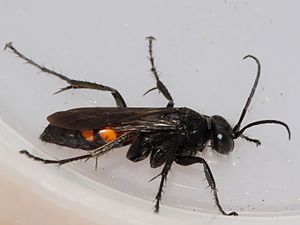Spring wasp
| Spring wasp | ||||||||||||
|---|---|---|---|---|---|---|---|---|---|---|---|---|

Spring wasp female |
||||||||||||
| Systematics | ||||||||||||
|
||||||||||||
| Scientific name | ||||||||||||
| Anoplius viaticus | ||||||||||||
| ( Linnaeus , 1758) |
The spring wasp ( Anoplius viaticus ) is a hymenoptera from the family of the wasp (Pompilidae).
features
The animals reach a body length of 9 to 14 millimeters (females) or 8 to 11 millimeters (males). The first three tergites of the abdomen are colored brick-red on top. One can recognize the species well by its basal, angled black bands on these three tergites. The male has a shortened last sternite . The sixth tergite is heavily bristled and is used to move sand for nest building.
Occurrence
The species occurs in North Africa , Europe and east to the Middle East . It colonizes various dry habitats with sandy soils such as inland dunes, sand pits and sand paths. The animals fly in one generation from late April to early September. The species is widespread in Central Europe.
Way of life
The species has an unusual generation succession for wasps. The females overwinter as adults in the ground and then build their brood cells until late summer. They first hunt their prey, mostly wolf spiders , lay them down for a long time and only then start building their nests. It can happen that other females of this species try to prey on the deposited spider. After the prey has been pulled into a tunnel dug in the sand, a single egg is placed on top and the brood cell is sealed. The new generation hatches very soon and develops in a few days using the stored spider as a source of food. After the mating season, the males soon die and the fertilized females prepare for their wintering in the sandy soil in late summer without creating new brood cells this year. The cycle does not begin again until the next year. The species is parasitized by the cuckoo wasp Evagetes proximus .
Systematics
The spring wasp belongs to the tribe Pompilini within the subfamily Pompilinae. Within the genus Anoplius it is counted to the subgenus Arachnophroctonus .
supporting documents
literature
- Rolf Witt: Wasps. Observe, determine. Naturbuch-Verlag, Augsburg 1998, ISBN 3-89440-243-1 .
Individual evidence
- ↑ Spring wasp at Insektenbox.de
Web links
- Anoplius viaticus in Fauna Europaea
- www.naturbildarchiv-guenter.de Picture story on biology, in particular hunting behavior, nest building and egg laying, of the wasp Anoplius viaticus